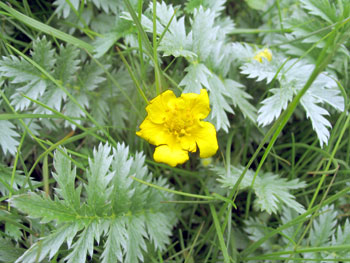THE STUDY OF THE DOMINANT GROUPS OF BIOLOGICALLY ACTIVE SUBSTANCES AND BIOELEMENTS IN SOME PLANTS OF THE FAMILY ROSACEAE
Abstract
To determine the content of the dominant groups of biologically active substances (tannins, polysaccharides, flavonoids) and bioelements in aerial parts of ten species of the Rosaceae family, which grows in Siberia: Potentilla anserina L., P. longifolia Willd., P. canescens Besser, P. bifurca L., P. tergemina Sojak, P. argentea L., P. goldbachii Rupr., P. sericea Dulac., Agrimonia pilosa Ledeb., Filipendula ulmaria (L.) Maxim. To determine the concentrations of essential and conditionally essential trace elements defined by the method of atomic emission spectroscopy. First identified plants of the genus Potentilla (P. canescens, P. tergemina) and Filipendula (F. ulmaria), accumulate significant quantities of lithium – 14,6, and 11,0 13,3 mg/kg, respectively, making them promising for further studies on the isolation and identification of active substances with the aim of creating innovative drugs. Investigated the content of heavy metals (Pb, Hg, As, Cd), the values of which meets regulatory requirements. Useful properties of the examined species family Rosaceae are determined by the content of biologically active substances (flavonoids, polysaccharides, tannins) and the complex of macro - and micronutrients. It is revealed that a dominant position in the spectrum belongs to the macronutrients potassium, calcium and magnesium (4,300 to 27,000 mg/kg). Among micronutrients the leading role is copper, followed by iron, silicon and manganese having important biological value, in particular, involved in the process of hematopoiesis.
Downloads
Metrics
References
Lovkova M.Ia., Buzuk G.N., Sokolova S.M., Dereviago L.N. Mikroelementy v meditsine, 2005, no. 4, pp. 3−10. (in Russ.).
Zhang Q., Peng S., Ni M. Spectrosc. Spectral. Anal., 1999, vol. 19, no. 2, pp. 203−205.
Litvinova T.N., Vyskubova N.K., Nenasheva L.V. Biogennye elementy. Kompleksnye soedineniia. [Nutrients. Complex Connections]. Rostov-na-Donu, 2009, 283 p. (in Russ.).
Zamoshchina T.A. Biulleten' sibirskoi meditsiny, 2006, no. 2, pp. 26–30. (in Russ.).
Kudrin A.V., Skal'nyi A.V. Mikroelementy v meditsine, 2001, no. 2, pp. 31−39. (in Russ.).
Curran G., Ravindran A. Expert Rev. Neurother., 2014, vol. 14, no. 9, pp. 1079–1098.
Ostacher M.J., Suppes T., Carlson B. Int. J. of Bipolar Disorders., 2015, no. 3(11), pp. 1−9.
Sakamoto Y., Ogawa T., Ogawa M. Yakugaku Zasshi., 2015, vol. 135, no. 1, pp. 151–158.
Krylov G.V. Travy zhizni i ikh iskateli. [Herbs of life and their seekers]. Tomsk, 1992, 392 p. (in Russ.).
Makhov A.A. Zelenaia apteka: Lekarstvennye rasteniia Krasnoiarskogo kraia. [Green pharmacy: Medicinal plants of the Krasnoyarsk Territory]. Krasnoiarsk, 1980, 352 p. (in Russ.).
Cokolov P.D. Rastitel'nye resursy SSSR: Tsvetkovye rasteniia, ikh khimicheskii sostav, ispol'zovanie. Semei-stva Hy-drangeaceae-Haloragaceae. [Plant resources of the USSR: Flowering plants, their chemical composition, use. Hydran-geaceae-Haloragaceae]. Leningrad, 1987, 326 p. (in Russ.).
Popov S.V., Popova G. Yu., Ovodova R.G., Ovodov Yu.S. Fitoterapia, 2005, vol. 76, pp. 281−287.
Tomczyk M., Leszczynska K., Jakoniuk P. Fitoterapia, 2008, vol. 79, pp. 592–594.
Bolotova V.Ts., Skliarevskaia N.V., Popova K.V. Farmatsiia, 2014, no. 6, pp. 54−56. (in Russ.).
Bazilko A., Tomczyk M., Flazińska A., Lęgas A. Journal of Planar Chromatography, 2011, vol. 24, pp. 441−444.
Bazilko A., Piwowarski J.P., Filipek A., Bonarevicz J., Tomczyk M. Journal of Ethnopharmacology, 2013, vol. 149, pp. 222−227.
Lavrenova G.V., Lavrenov V.K. Entsiklopediia lekarstvennykh rastenii. [Encyclopedia of Medicinal Plants]. Donetsk, 1997, vol. 2, 500 p. (in Russ.).
Shreter A.I., Valentinov B.G., Naumova E.M. Prirodnoe syr'e kitaiskoi meditsiny. [Natural raw materials of Chinese medicine]. Moskva, 2004, vol. 1, 506 p. (in Russ.).
Kato H., Li W., Koike M., Wang Y., Koike K. Phytochemistry, 2010, vol. 16, pp. 1925–1929.
Krasnov E.A., Avdeeva E.Iu. Khimiia rastitel'nogo syr'ia, 2012, no. 4, pp. 5–12. (in Russ.).
Avdeeva E.Iu., Krasnov E.A., Shilova I.V. Khimiia prirodnykh soedinenii, 2008, no. 3, pp. 115–118. (in Russ.).
Gosudarstvennaia farmakopeia Rossiiskoi Federatsii. [State Pharmacopoeia of the Russian Federation]. Moskva, 2015, 1003 p. (in Russ.).
PND F 16.1:2.3:3.11-98. Kolichestvennyi khimicheskii analiz pochv. Metodika vypolneniia izmerenii soderzha-niia metallov v tverdykh ob"ektakh metodom spektrometrii s induktivno-sviazannoi plazmoi. [HDPE F 16.1: 2.3: 3.11-98. Quantitative chemical analysis of soils. Method for measuring the content of metals in solid objects using spectrometry with inductively coupled plasma]. Moscow, 1998, 31 p. (in Russ.).
Gosudarstvennaia farmakopeia SSSR. [State Pharmacopoeia of the USSR]. Moscow, 1990, vol. 2, 400 p. (in Russ.).
Dobrovol'skii V.V. Osnovy biogeokhimii. [Fundamentals of biogeochemistry]. Moscow, 2003, 400 p. (in Russ.).
SanPiN 2.3.2.560-96. Prodovol'stvennoe syr'e i pishchevye produkty. Gigienicheskie trebovaniia k kachestvu i bezopas-nosti prodovol'stvennogo syr'ia i pishchevykh produktov. [SanPiN 2.3.2.560-96. Food raw materials and food products. Hygienic requirements to the quality and safety of food raw materials and food products]. Moscow, 1997, 270 p. (in Russ.).


This work is licensed under a Creative Commons Attribution 4.0 International License.
The authors, which are published in this journal, agree to the following conditions:
1. Authors retain the copyright to the work and transfer to the journal the right of the first publication along with the work, at the same time licensing it under the terms of the Creative Commons Attribution License, which allows others to distribute this work with the obligatory indication of the authorship of this work and a link to the original publication in this journal .
2. The authors retain the right to enter into separate, additional contractual agreements for the non-exclusive distribution of the version of the work published by this journal (for example, to place it in the university depository or to publish it in a book), with reference to the original publication in this journal.
3. Authors are allowed to post their work on the Internet (for example, in a university repository or on their personal website) before and during the review process of this journal, as this may lead to a productive discussion, as well as more links to this published work.











